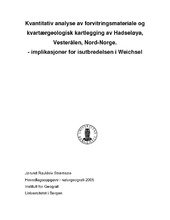Kvantitativ analyse av forvitringsmateriale og kvartærgeologisk kartlegging av Hadseløya, Vesterålen, Nord-Norge. - implikasjoner for isutbredelsen i Weichsel
Master thesis
Permanent lenke
https://hdl.handle.net/1956/1223Utgivelsesdato
2005Metadata
Vis full innførselSamlinger
- Department of Geography [627]
Sammendrag
“A quantitative analysis of weathered material and a geomorphological mapping ofHadseløya, Vesterålen, Northern Norway. – Implications for the Weichselian ice sheet extension” Hadseløya (102 km2) is the southernmost island (position 68° 30´N 15°E) in the Vesterålen archipelago located in Northern Norway constituting the study area for this thesis. The island is characterized by low-relief surfaces containing various kinds of weathering material, and a dissected landscape covered by glacial, periglacial and colluvial deposits and landforms. The spatial distribution of superficial deposits and landforms in the study area has previously received modest attention, and has been subject for only large-scale mapping. Still, some of these features have been applied in reconstructions of the Weichselian ice sheet configuration, and the Late-Weichselian deglaciation history of the region. With the aim of obtaining a better understanding of the physical properties of weathered material, a comprehensive analysis of the regolith has been carried out within a geomorphological context. The results are discussed against possible ice sheet scenarios. By combining XRD-analysis, grain-size distribution and geomorphological mapping,sedimentary characteristics of various weathered material has been documented, in addition to the spatial distribution of landforms. Five pits were excavated and logged in detail. Four of them are located on plateaus made up of in situ weathered material, whereas the fifth was located in a fluvial downcutting. All pits reveal either pedolithic material, saprolite structures or a combination of these. No glacigenic material was observed in the profiles. In the porous saprolite, which occasionally show corestones, original bedrock structures are preserved. In order to complement this approach an additional 14 localities were sampled (n=32). The pits were sampled at different depths for the purpose of analyzing both the vertical grain-size distribution and the mineralogical properties of the clay and silt fractions (< 63μm). The results from the grain-size analysis show uniformity both in, and between the pits, and may reflect the relatively similar physical properties of the local gneiss from which the weathered material derived. It is suggested that the original bedrock signature has a strong bearing on the grain-size distribution within the profiles. A comparison of weathered, glacial, periglaicial and colluvial material shows limited variations in the grain-size distribution and is interpreted as an expression of similar lithologic origin. The interpretation of the d-values derived from the XRD-analysis shows the presence of secondary minerals, e.g. gibbsite and kaolinite, commonly suggested to indicate pre-Weichselian or pre-Quaternary weathering. Moreover, the presence of the common gneissic constituents, quartz and feldspar are identified. In this study the XRD-analysis demonstrates the capability of this method (preferably in combination with other methods) in distinguishing between weathered and glacigenic material; where weathered material reflects the local lithology, whereas till also contains elements derived from the overridden bedrocks. Based on the mineralogical composition of the weathered material and the geomorphological distribution of landforms and superficial deposits it appears that the plateaus on Hadseløya represent a residuum from a paleic surface, and that till observed above 150-200 m asl can be attributed to the activity of local glaciers rather than a regional ice sheet. An exposure date sampled from this residuum on Storheia yield a minimum age of 43.34 ± 4.86 ka. Taken together these observations indicate a non-complete Fennoscandian ice sheet cover of Hadseløya during the Weichselian.
Utgiver
The University of BergenOpphavsrett
The authorCopyright the author. All rights reserved
